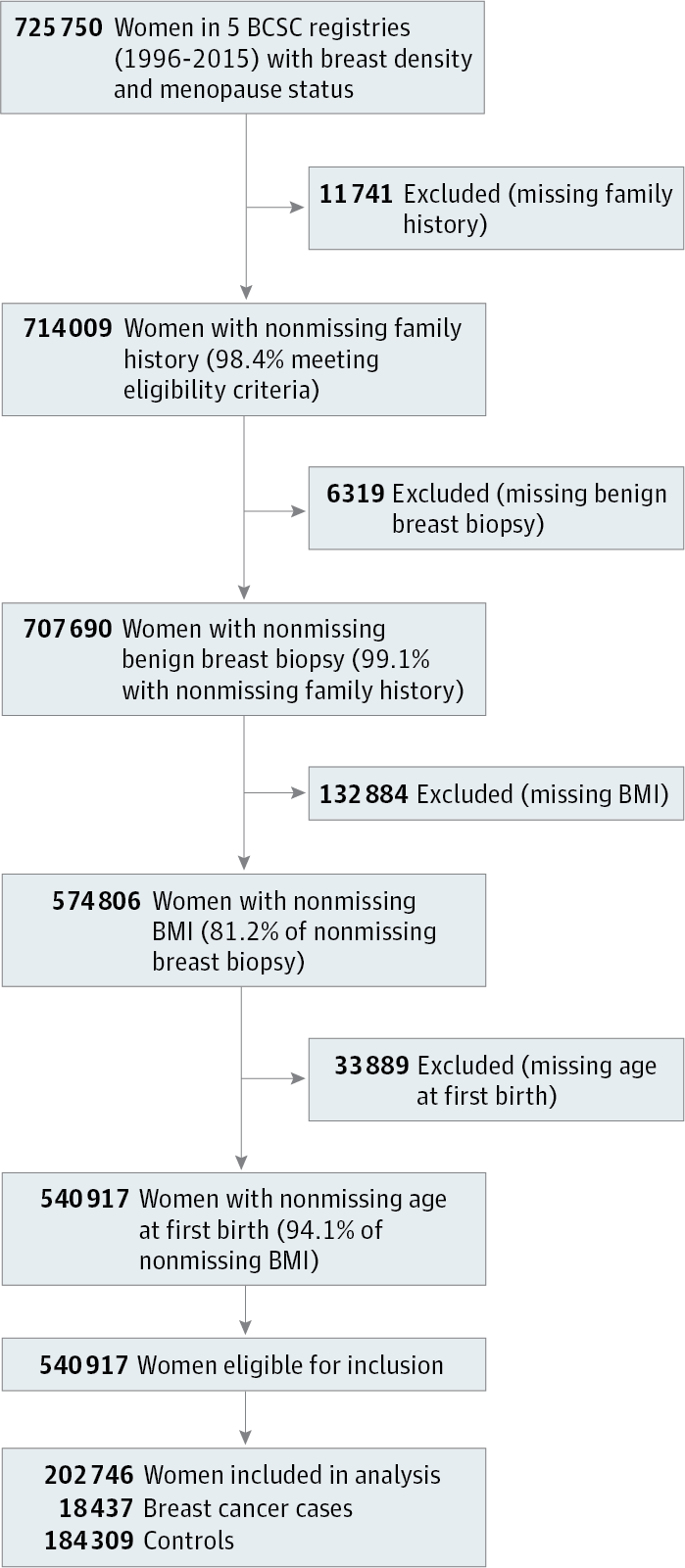JAMA Oncology ( IF 22.5 ) Pub Date : 2017-09-01 , DOI: 10.1001/jamaoncol.2016.6326 Natalie J Engmann 1 , Marzieh K Golmakani 2 , Diana L Miglioretti 2, 3 , Brian L Sprague 4 , Karla Kerlikowske 1, 5 ,

|
Importance Many established breast cancer risk factors are used in clinical risk prediction models, although the proportion of breast cancers explained by these factors is unknown.
Objective To determine the population-attributable risk proportion (PARP) for breast cancer associated with clinical breast cancer risk factors among premenopausal and postmenopausal women.
Design, Setting, and Participants Case-control study with 1:10 matching on age, year of risk factor assessment, and Breast Cancer Surveillance Consortium (BCSC) registry. Risk factor data were collected prospectively from January 1, 1996, through October 31, 2012, from BCSC community-based breast imaging facilities. A total of 18 437 women with invasive breast cancer or ductal carcinoma in situ were enrolled as cases and matched to 184 309 women without breast cancer, with a total of 58 146 premenopausal and 144 600 postmenopausal women enrolled in the study.
Exposures Breast Imaging Reporting and Data System (BI-RADS) breast density (heterogeneously or extremely dense vs scattered fibroglandular densities), first-degree family history of breast cancer, body mass index (>25 vs 18.5-25), history of benign breast biopsy, and nulliparity or age at first birth (≥30 years vs <30 years).
Main Outcomes and Measures Population-attributable risk proportion of breast cancer.
Results Of the 18 437 women with breast cancer, the mean (SD) age was 46.3 (3.7) years among premenopausal women and 61.7 (7.2) years among the postmenopausal women. Overall, 4747 (89.8%) premenopausal and 12 502 (95.1%) postmenopausal women with breast cancer had at least 1 breast cancer risk factor. The combined PARP of all risk factors was 52.7% (95% CI, 49.1%-56.3%) among premenopausal women and 54.7% (95% CI, 46.5%-54.7%) among postmenopausal women. Breast density was the most prevalent risk factor for both premenopausal and postmenopausal women and had the largest effect on the PARP; 39.3% (95% CI, 36.6%-42.0%) of premenopausal and 26.2% (95% CI, 24.4%-28.0%) of postmenopausal breast cancers could potentially be averted if all women with heterogeneously or extremely dense breasts shifted to scattered fibroglandular breast density. Among postmenopausal women, 22.8% (95% CI, 18.3%-27.3%) of breast cancers could potentially be averted if all overweight and obese women attained a body mass index of less than 25.
Conclusions and Relevance Most women with breast cancer have at least 1 breast cancer risk factor routinely documented at the time of mammography, and more than half of premenopausal and postmenopausal breast cancers are explained by these factors. These easily assessed risk factors should be incorporated into risk prediction models to stratify breast cancer risk and promote risk-based screening and targeted prevention efforts.
中文翻译:

乳腺癌临床危险因素的人群归因风险比例
重要性 许多已确定的乳腺癌风险因素被用于临床风险预测模型,尽管这些因素所解释的乳腺癌比例尚不清楚。
目的 确定绝经前和绝经后女性乳腺癌的人群归因风险比例(PARP)与临床乳腺癌危险因素的相关性。
设计、设置和参与者 病例对照研究,在年龄、危险因素评估年份和乳腺癌监测联盟 (BCSC) 登记方面进行 1:10 匹配。风险因素数据是从 BCSC 社区乳腺成像设施前瞻性收集的,从 1996 年 1 月 1 日到 2012 年 10 月 31 日。共有 18 437 名患有浸润性乳腺癌或导管原位癌的女性作为病例入组,并与 184 309 名未患乳腺癌的女性进行匹配,共有 58 146 名绝经前女性和 144 600 名绝经后女性参加了该研究。
暴露 乳腺影像报告和数据系统 (BI-RADS) 乳腺密度(异质或极其致密与分散的纤维腺体密度)、乳腺癌一级家族史、体重指数(>25 vs 18.5-25)、良性乳腺病史活检,以及未生育或第一胎年龄(≥30 岁 vs <30 岁)。
主要结果和措施 乳腺癌的人群归因风险比例。
结果 在 18 437 名乳腺癌女性中,绝经前女性的平均 (SD) 年龄为 46.3 (3.7) 岁,绝经后女性的平均 (SD) 年龄为 61.7 (7.2) 岁。总体而言,4747 名 (89.8%) 绝经前和 12 502 名 (95.1%) 绝经后乳腺癌女性至少有 1 个乳腺癌危险因素。所有危险因素的合并 PARP 在绝经前女性中为 52.7%(95% CI,49.1%-56.3%),在绝经后女性中为 54.7%(95% CI,46.5%-54.7%)。乳房密度是绝经前和绝经后女性最普遍的危险因素,对 PARP 的影响最大;如果所有乳房不均匀或极其致密的女性转变为分散性纤维腺癌,则 39.3%(95% CI,36.6%-42.0%)的绝经前乳腺癌和 26.2%(95% CI,24.4%-28.0%)的绝经后乳腺癌可能是可以避免的。乳房密度。在绝经后女性中,如果所有超重和肥胖女性的体重指数都低于 25,则 22.8%(95% CI,18.3%-27.3%)的乳腺癌可能是可以避免的。
结论和相关性 大多数乳腺癌女性在进行乳房 X 光检查时至少有 1 个常规记录的乳腺癌危险因素,并且超过一半的绝经前和绝经后乳腺癌是由这些因素解释的。这些易于评估的风险因素应纳入风险预测模型中,以对乳腺癌风险进行分层,并促进基于风险的筛查和有针对性的预防工作。











































 京公网安备 11010802027423号
京公网安备 11010802027423号